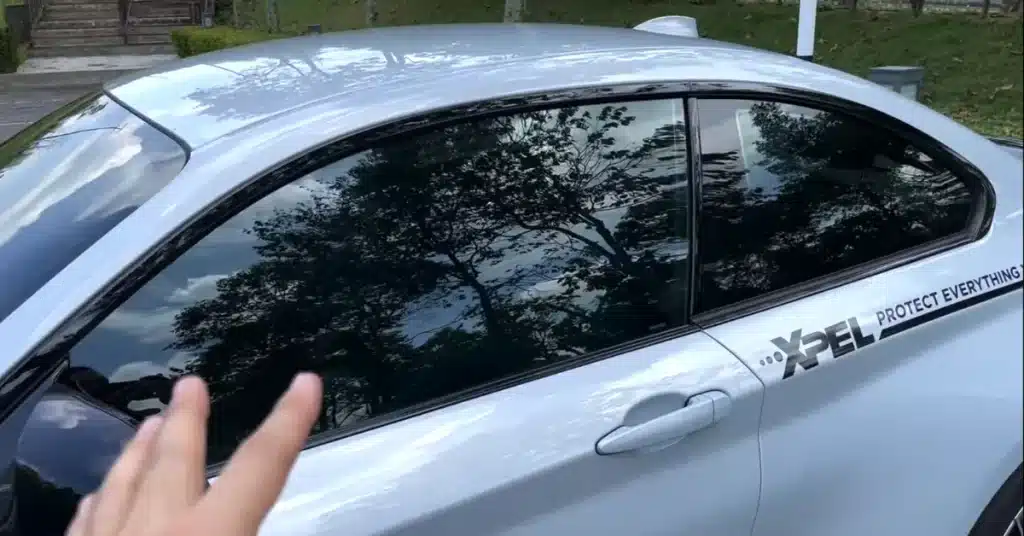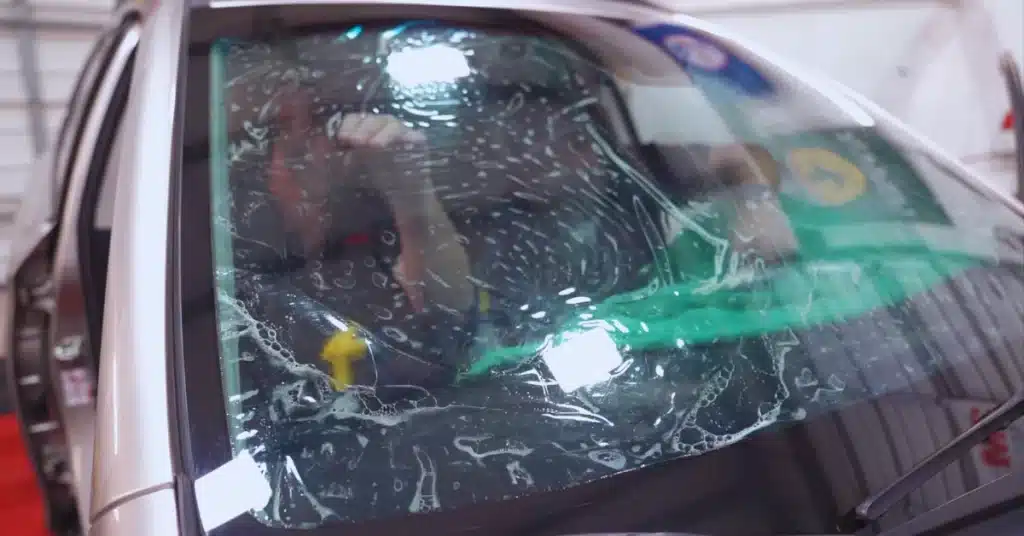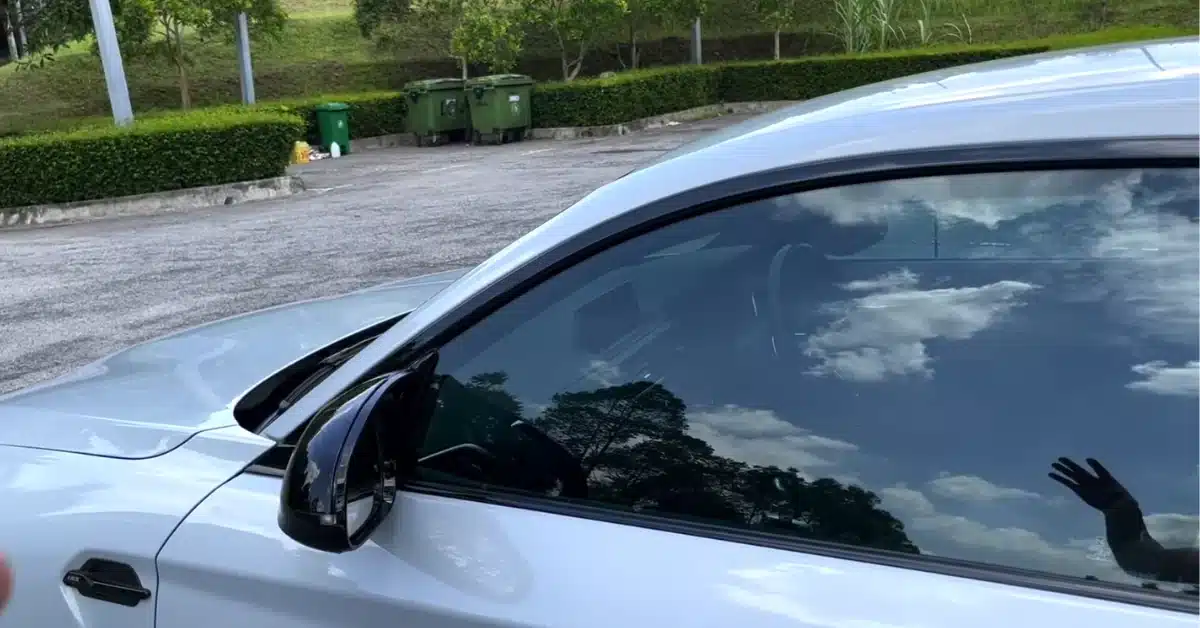I will compare two popular automotive window tint films in this article: Xpel Prime XR Plus vs. 3M Crystalline.
Both films are renowned for their superior performance and innovative features, but they have distinct characteristics that make them unique.
Join me as we delve into the world of automotive window tinting and explore the similarities and differences between Xpel Prime XR Plus and 3M Crystalline.
Read More: XPEL vs. 3M Window Tint
Xpel Prime XR Plus vs. 3M Crystalline
Xpel Prime XR Plus

Xpel Prime XR Plus is a high-performance window tint film that offers exceptional heat rejection and UV protection.
It is constructed using advanced nano-ceramic technology, allowing superior clarity and color stability.
The film is designed to provide optimal comfort and protection for the driver and passengers.
The Xpel Prime XR Plus film boasts an impressive total solar energy rejection (TSER) rating of up to 98%, effectively reducing heat buildup inside the vehicle.
This feature enhances the overall driving experience by keeping the cabin cooler, especially during the hot summer.
Furthermore, Xpel Prime XR Plus offers excellent UV ray protection, blocking up to 99% of harmful UV radiation.
This safeguards the occupants and helps preserve the vehicle’s interior from fading and deterioration caused by prolonged sun exposure.
Read More: XPEL Window Tint vs. LLumar
3M Crystalline
3M Crystalline is another highly regarded window tint film with advanced technology to provide superior performance.
This film is engineered using multi-layer optical film (MOF) technology, allowing optimal heat rejection while maintaining exceptional clarity.
One of the standout features of 3M Crystalline is its ability to block a significant amount of infrared (IR) radiation.
By reducing IR radiation, the film effectively minimizes heat transfer into the vehicle, creating a cooler and more comfortable interior environment.
Additionally, 3M Crystalline offers excellent UV protection by blocking up to 99.9% of harmful UV rays. This helps protect the occupants from the adverse effects of UV radiation and prevents interior fading and discoloration.

| Features | Xpel Prime XR Plus | 3M Crystalline |
|---|---|---|
| Heat Rejection | Up to 98% TSER | IR heat reduction |
| UV Protection | Blocks up to 99% UV | Blocks up to 99.9% UV |
| Clarity and Visibility | Exceptional clarity | Optimal visibility |
| Installation | Professional required | Professional required |
| Durability | Scratch-resistant | Scratch-resistant |
| Warranty | Varies by installer | Varies by installer |
| Price | Premium | Premium |
Heat Rejection Performance
When it comes to heat rejection performance, both Xpel Prime XR Plus and 3M Crystalline excel. However, they employ different technologies to achieve this.
Xpel Prime XR Plus utilizes nano-ceramic particles embedded within the film, effectively blocking and reflecting a significant amount of solar heat.
This results in a cooler cabin and reduces the reliance on air conditioning, leading to potential energy savings.
On the other hand, 3M Crystalline employs multi-layer optical film technology, which selectively blocks infrared radiation. By targeting specific wavelengths, this film reduces heat buildup inside the vehicle while allowing visible light to pass through with minimal distortion.
UV Protection
Protection against harmful UV radiation is a crucial factor to consider when choosing a window tint film.
Both Xpel Prime XR Plus and 3M Crystalline offer outstanding UV protection, making them ideal for drivers and passengers concerned about their skin health and the longevity of their vehicle’s interior.
With Xpel Prime XR Plus, up to 99% of harmful UV rays are blocked, ensuring a safer and healthier driving experience.
This film’s ability to filter UV radiation effectively reduces the risk of skin cancer and prevents premature aging caused by sun exposure.
Similarly, 3M Crystalline excels in UV protection, blocking up to 99.9% of harmful UV rays.
This film’s high level of UV rejection helps protect the skin and minimizes the fading and deterioration of the vehicle’s interior surfaces, such as seats, dashboards, and trim.
Clarity and Visibility
Both Xpel Prime XR Plus and 3M Crystalline prioritize excellent clarity and visibility, ensuring a safe and enjoyable driving experience.
Xpel Prime XR Plus employs nano-ceramic technology, allowing for exceptional optical clarity. This film minimizes distortion, glare, and haze, resulting in a crystal-clear view of the road and surroundings.
The high visible light transmission (VLT) rating of Xpel Prime XR Plus ensures that the tint film does not compromise visibility during daytime or nighttime driving.
3M Crystalline, with its multi-layer optical film technology, also excels in providing exceptional clarity and visibility.
This film is designed to maintain a high level of light transmission while effectively reducing glare. The result is a clear and unobstructed view, enhancing safety on the road.
Installation and Durability
Both Xpel Prime XR Plus and 3M Crystalline are professionally installed films that require expertise and precision to ensure optimal performance and longevity.
The installation process for Xpel Prime XR Plus involves meticulous preparation and application techniques to achieve a flawless result.
The film adheres to the glass surface seamlessly, creating a uniform and aesthetically pleasing appearance.
Similarly, 3M Crystalline requires professional installation to guarantee proper fitment and long-lasting performance. Expert installers utilize specialized tools and techniques to ensure the film adheres evenly and without any imperfections.
In terms of durability, both films are designed to withstand the rigors of daily use. They are scratch-resistant and provide added protection to the glass surface.
However, it’s important to note that the longevity of the film can vary depending on factors such as climate, maintenance, and driving conditions.
Warranty and Price
Warranty coverage and pricing are crucial considerations when choosing between Xpel Prime XR Plus and 3M Crystalline.
Xpel offers a comprehensive warranty for Prime XR Plus, which includes protection against discoloration, fading, bubbling, and peeling.
The warranty duration can vary depending on the installer and location, so checking the specific terms and conditions is essential.
3M Crystalline also has a warranty covering various aspects such as color stability, film defects, and adhesive failure.
Similar to Xpel Prime XR Plus, the warranty details can vary, so it’s important to review the specific terms provided by the installer.
As for pricing, both Xpel Prime XR Plus and 3M Crystalline are premium window tint films, and their cost can vary based on the vehicle type, size, and the installer’s pricing structure.
Obtaining quotes from reputable installers to compare the overall value and pricing options is recommended.
Read More: XPEL XR vs. XPEL XR Plus
Read More: XPEL XR Black vs. XR Plus
Is XPEL or 3M tint better?
Both XPEL and 3M are reputable companies offering high-quality window tinting products. Both have a range of films for different purposes.
Check customer reviews, warranties, and local regulations to decide which is better for your needs and budget. Proper installation is crucial for effectiveness.
Is XPEL a good tint brand?
Yes, XPEL is generally considered a good tint brand known for its high-quality window films, durability, and performance in the automotive industry.
It’s popular among car enthusiasts and professional installers for its advanced technology and positive reputation. Always check customer reviews and compare them with other brands to ensure it fits your specific needs.
Andy’s Opinion
In conclusion, both Xpel Prime XR Plus and 3M Crystalline are exceptional window tint films with advanced features and superior performance. The decision between the two ultimately depends on individual preferences and specific requirements.
Xpel Prime XR Plus stands out with its nano-ceramic technology, exceptional heat rejection, and high UV protection.
This film offers a combination of comfort, clarity, and long-term durability, making it an excellent choice for those seeking top-of-the-line performance.
On the other hand, 3M Crystalline showcases its multi-layer optical film technology, impressive infrared heat rejection, and excellent UV protection.
With its emphasis on clarity, visibility, and a cool interior environment, this film appeals to drivers who prioritize comfort and aesthetics.
Ultimately, consulting with professional installers and requesting samples or demonstrations is recommended to experience the performance of Xpel Prime XR Plus and 3M Crystalline firsthand.
Doing so lets you make an informed decision based on your specific needs and preferences.
Whether you choose Xpel Prime XR Plus or 3M Crystalline, both films offer exceptional quality and performance, enhancing your driving experience while providing comfort, protection, and style.





